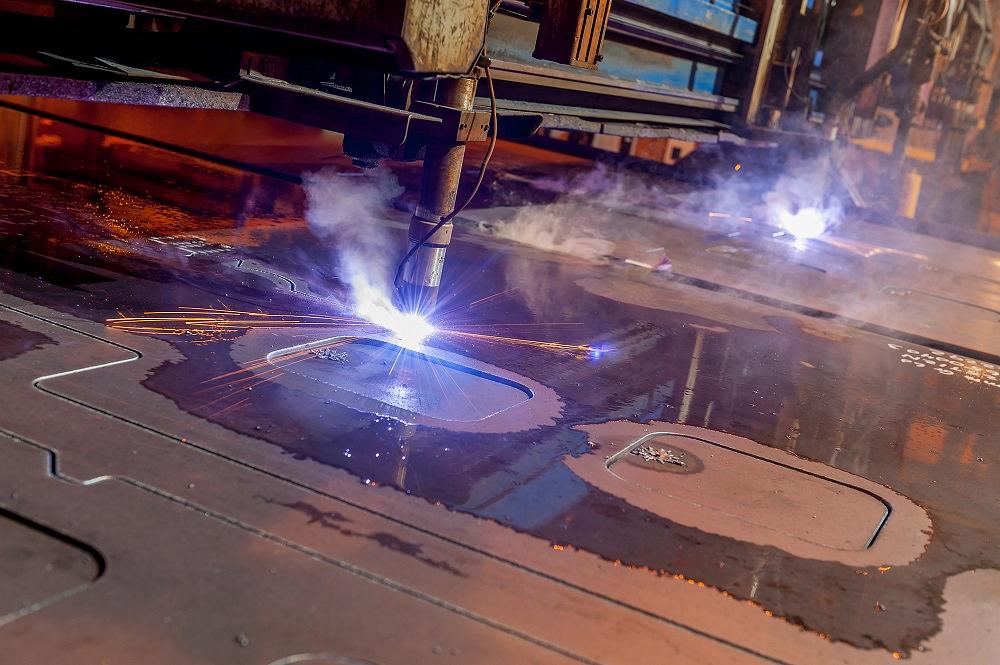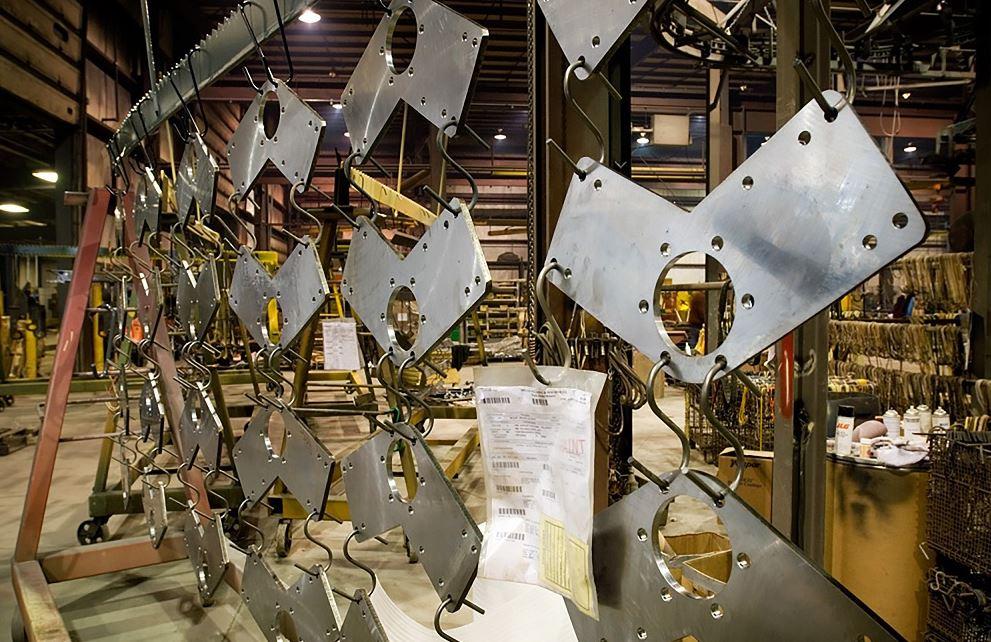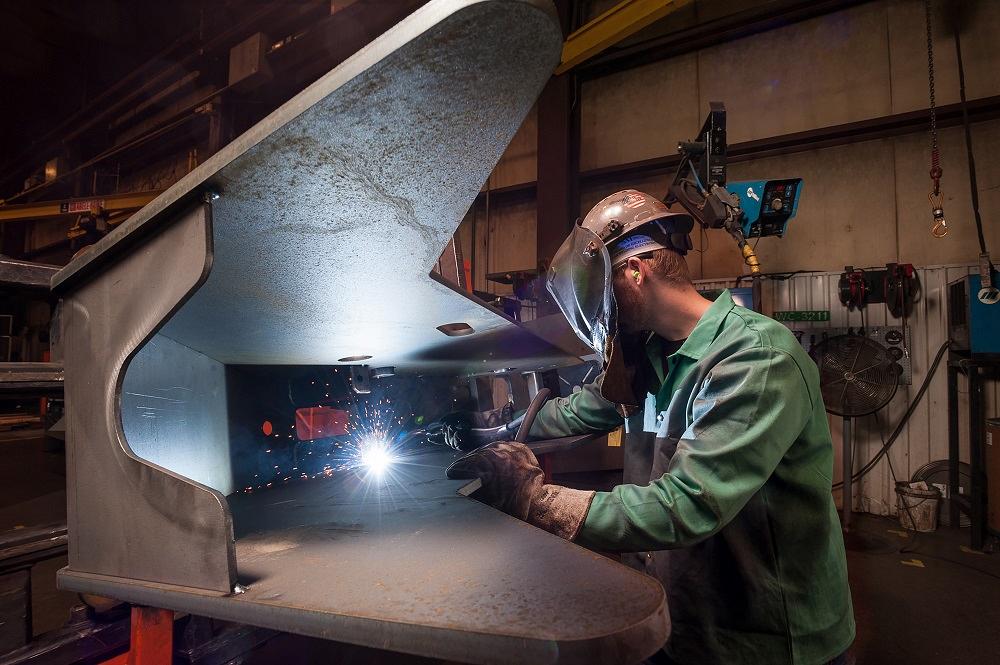Senior Editor
- FMA
- The Fabricator
- FABTECH
- Canadian Metalworking
Categories
- Additive Manufacturing
- Aluminum Welding
- Arc Welding
- Assembly and Joining
- Automation and Robotics
- Bending and Forming
- Consumables
- Cutting and Weld Prep
- Electric Vehicles
- En Español
- Finishing
- Hydroforming
- Laser Cutting
- Laser Welding
- Machining
- Manufacturing Software
- Materials Handling
- Metals/Materials
- Oxyfuel Cutting
- Plasma Cutting
- Power Tools
- Punching and Other Holemaking
- Roll Forming
- Safety
- Sawing
- Shearing
- Shop Management
- Testing and Measuring
- Tube and Pipe Fabrication
- Tube and Pipe Production
- Waterjet Cutting
Industry Directory
Webcasts
Podcasts
FAB 40
Advertise
Subscribe
Account Login
Search
How a top metal fabricator perfects its material handling
Miller Fabrication Solutions’ strategy focuses on flow throughout the fab shop
- By Tim Heston
- August 19, 2022
- Article
- Materials Handling

An employee at Miller Fabrication Solutions prepares a sling to manipulate a workpiece in an orientation that will best suit the next operation. Images: Miller Fabrication Solutions
If you study how material moves through a typical custom or contract metal fabricator, especially ones with multiple plants, you might find that metal spends surprisingly little time being cut, bent, and welded. Instead, it spends most of its time just, well, sitting there, be it in raw stock, as work-in-process (WIP) between workstations, and on flatbed trucks being transported between plants.
Rich Steel knows this all too well, and as director of lean manufacturing at Miller Fabrication Solutions, he’s spent much of his career doing something about it. Steel and the team at the Brookville, Pa., contract metal fabricator have tackled material handling challenges between facilities as well as between individual workstations. Most recently, company leaders are planning some substantial changes on the horizon. Within the next few years, some foundational elements of material movement throughout the company will likely look very different.
Movement Between Facilities
“Years ago, we had a lot of make-to-order-style processing,” Steel said. “Studying how we moved parts within and between facilities, we created spaghetti diagrams that just looked horrendous. We had long travel distances, and we had a lot of choke points that occurred at the component-fabrication level. We’d burn parts in one facility, move them to another facility for press brake work, then move those same parts back to the original facility for final processing before sending them all to yet another plant for top-level assembly.”
Miller has two major fabrication facilities in the Brookville area. The main one, called Sandy Lick, sits near Redbank Creek; the other, called Maplevale, is just north of I-80. They’re both about 50 miles north of Miller’s third plant in Homer City, Pa.
“Many times, we’ve brought together a cross-functional team that puts together value stream maps, process maps, and spaghetti diagrams,” Steel said. “By using these mapping tools, we began to see the inefficiencies and explore our options.”
Many job routings move parts through multiple plants for practical reasons, often because of certain monument processes, like powder coating, can’t be easily moved or replicated. But as Steel and his coworkers found, not all jobs moved between multiple plants out of necessity. Steel described one job that required profile-cutting a rectangular tube, 12 by 10 in. with a 0.5-in. wall thickness. The tube had been laser-cut by an outside supplier, but several years ago that supplier stopped providing the service. So, Miller had to find a way to get the job done in-house.
As a short-term solution, the fabricator sawed the tubes at Sandy Lick, hand-plasma-cut the end profiles in Maplevale, sent the tubes to Homer City for assembly, then back to Maplevale for painting, packaging, and shipping. “This tube was in all three facilities, including one facility twice,” Steel said. “By undergoing process mapping, we consolidated the operation.”
Some of this consolidation involved turning to a previously underutilized robotic plasma cutting system in Homer City to profile-cut the tubes. However, if the team had focused solely on manufacturing technology (and eliminating the need for plasma cutting by hand), they would have lost sight of the bigger picture and missed the greatest opportunity for improvement: eliminating all that unnecessary movement between plants.
“We consolidated everything in Homer city, where we sawed the part; plasma-cut the profiles with a robot; performed the top-level assembly, welding, and machining; then went on to painting, packaging, and shipping. By revisiting and mapping the process, we came up with a much better solution.”
Not every job can be consolidated in such a way, of course. Again, certain plants have processes that can’t be easily moved. “We still produce some parts that hit all three plants at some point,” Steel said. “But when we do mapping, we now factor in that waiting and transportation time between plants.”

At Miller Fabrication Solutions, processes are optimized for smooth workflow, ensuring parts are optimally presented to processes downstream.
Miller avoids looking at between-facility transportation in isolation without considering the needs of the people who receive the work within the plants. For instance, the most “efficient” way to move work between plants would be to fill up a truck with a large batch of work. But as Steel explained, this propagates the inefficiencies of batch-and-queue. If a customer ordered 50 components, one plant would produce all 50 and then move them to another plant, where that large batch of 50 would lumber through subsequent manufacturing steps. Larger batches led to more WIP, which led to longer lead times. “Now, we might break an order into a smaller quantity,” Steel said, “and deliver more frequently.”
Linking Processes for Better Handling
Looking at any manufacturing step in isolation can be the Achilles’ heel for a fabricator aiming to ease material handling and boost throughput. This, Steel explained, is where process linking can help. He described a plasma operation that cuts large, 1.5-in.-thick plates that are processed through a deslagging machine before being sent downstream to a machining center.
In a batch-and-queue arrangement, operators would cut multiple plates, stack them, then move them again to where they’d be lifted (again) and sent through deslagging before traveling to machining. Instead of relying on batch-and-queue, though, Miller worked to “link” plasma cutting to deslagging and machining.
As parts were cut, they would move immediately to deslagging before moving on to machining. And instead of moving parts in one large batch that could sit as WIP for days in the machining department, the company timed the operation so that machinists would receive a specific number of parts at a specific time of day, when the vertical machining centers had capacity to run and move the job to the next step. Linking plasma cutting, deslagging, and machining in this way created one manufacturing step—call it the “plasma-deslag-machining process”—with a predictable takt time.
Linking processes helped everyone think beyond their workcell and about overall job flow, including how parts are presented to operations downstream. Steel described a prime example. “A machining operator noticed that every time he received a part, he had to spin them 180 degrees. He started asking why.” Spinning the part didn’t take too long, “but in order for him to machine parts in the right amount of time, he had to quickly load and unload to minimize the time from part to part. It was important to have parts oriented the right way before loading them onto the machine.”
A fork truck delivered these parts from the plasma-deslagging operation, about 30 ft. away. There, the plasma table operator used a jib crane with a magnet to lift these large, heavy parts onto carts, which eliminated the need for a fork truck between the plasma table and deslagging. Of course, the slag from plasma cutting is on the underside of the part, which means that operators still use a jib crane to turn over each heavy piece before it enters the deslagging center.
When the machining center operator saw this in action, he started talking to his fellow operators in deslagging. Considering they were already flipping these parts, could they also rotate it 180 degrees? As it turned out, the deslag operators had no trouble rotating the plate. The change happened immediately—no strategy meetings, no poring over metrics, just a healthy dose of common sense and open communication between operators.
Thinking about manufacturing steps as “linked” helps here. If Miller looked at cutting, deslagging, and machining in isolation, employees would likely process large batches and overlook all the arduous handling in between.
Linked processes need not be physically close to each other either. Steel described plates that would sit flat in a machining center in one facility, then be shipped to another facility where someone else would lift them to a vertical position into an assembly fixture. Transporting plates flat on a truck seems like the most obvious, common-sense way to move them from one plant to another—but only when looking at trucking in isolation.
As it turned out, the way those plates were delivered to assembly had a significant impact on overall throughput. Assemblies required a left- and right-hand plate to be affixed vertically—a feat easier said than done when large, heavy workpieces are involved. To handle it all, workers in a kitting area, situated before assembly, manipulated and staged pieces for assembly.

Cut blanks are hung on carriages that help operators easily transfer them to the powder coating line.
Miller employees again started asking questions: Could machining, trucking between facilities, and assembly be linked for this job? This time, it wasn’t practical to consolidate all operations into one facility, but again, just because processes aren’t physically close to each other doesn’t mean they can’t be linked.
In this case, the team developed a custom rack that carries parts as they’re offloaded from machining, trucked to another facility, and presented to assembly—this time in the vertical orientation. With customer approval, the team drilled a small hole at the top of each plate, allowing the machining operator to put a J hook into the part, lift it vertical, and place it into a rack that holds just one left- and one right-hand part. That rack then goes directly onto a truck.
Before, loose parts were stacked, banded, and placed on a truck bed, an approach that required a kitting department at the destination facility. Now, parts arrive at the facility on racks that go straight to assembly, no kitting department required. In this sense, machining in one facility is now linked to an assembly operation at another facility. Sure, lifting pieces vertically into a rack after machining takes a little time, but that’s nothing compared to the hours saved in assembly.
“It also made it easier to transport pieces between facilities,” Steel said. “The racks eliminated the need for any banding [of loads on the bed]. Moreover, because of the way we designed the racks, a fork truck could move two racks at a time.” This sped truck loading and unloading, which streamlined operations even further.
On top of all this, empty racks now could be used as kanban replenishment signals. When the assembly department consumed pieces in a rack, that rack was sent back to the other facility where it signaled the machining department to replenish and machine more parts. “They now know if they receive empty racks, they need to replenish them,” Steel said. “If they don’t see any racks, they know they don’t need to machine any additional parts for this job.”
The idea of process linking has extended even to traditional batch processes, including automated powder coating. The fabricator might be able to move an assembly operation adjacent to a cutting and bending operation, but it can’t just pick up and move an automated powder line that uses a combination of mechanized guns and powder coating robotics. Miller’s powder system sits within the last bay of the Maplevale plant, and in recent years the company has moved fabrication and machining processes to better feed the line.
Because of curing and color-change requirements, powder coating remains a constraint process. So, to ensure the constraint is constantly fed, Miller employees scrutinized how parts were presented to the operators hanging parts. They noticed that for one repeat job, operators struggled to hang four large parts onto the line.
To find a solution, they looked to link an upstream process—in this case, machining. How could parts emerging from plate machining be better presented to powder coating? “We ended up creating a unique carrier where machining operators could hang parts,” Steel said, adding that the carrier held parts oriented and spaced in a way that helped make part-hanging easier at powder coating. “Now, once that carrier reaches powder coating, operators can quickly lift parts out and hang them in the right orientation. Their job is easier, and the entire process flow is a lot smoother.”
Component Factory on the Horizon
Miller’s material handling strategies focus on linking processes, smoothing material flow throughout the value stream, and eliminating unneeded transfers between facilities—which is why Miller’s future plans seem a bit counterintuitive. In 2021, Miller purchased a new facility in Brookville.
“Our aim is for this new facility to be a smart factory,” Steel said, “complete with automated guided vehicles and robotics, all loading and sorting parts from plasma tables and laser cutting centers. Our goal, the future state of this project, is for the plant to be a shared resource for component manufacturing, from which we’ll release kits to the other three facilities where we’ll do top-level production.”

A welder works on an assembly with pieces that came from upstream processes like plasma cutting, grinding, and machining. For these kinds of heavy fabrications in particular, the right material handling strategy can make a real difference.
That sounds great, but what about all that excess transportation?
“Yes, we’ll add more transportation,” Steel responded. “We’ll be moving every component from the new facility to another facility, guaranteed. But we’ll be moving them as kits, and we’ll be producing them much more efficiently. We can utilize more kanban replenishment, more pull systems, and we’ll need to deal with a lot less transportation to produce the components themselves.”
Miller has reduced handling and eased part flow under its current structure, but the initiatives haven’t distracted company leaders from some big-picture thinking. Consolidating all component manufacturing under one roof will unleash new levels of capacity. The arrangement will give the company what amounts to an “internal” supplier of cut, formed, and welded sheet metal and plate components.
The idea, Steel said, is for the facility to produce components at just the right pace, the right quantity, and presented in just the right way to make life easier for those in upper-level joining and assembly operations at the other three plants. It’s an idea that pervades even the smallest sheet metal job shop. The more reliably upstream processes, like laser cutting and bending, can present work to final assembly and shipping, the more predictable an operation can be. Miller’s component-factory concept just helps scale up that idea and build a foundation for future growth.
About the Author

Tim Heston
2135 Point Blvd
Elgin, IL 60123
815-381-1314
Tim Heston, The Fabricator's senior editor, has covered the metal fabrication industry since 1998, starting his career at the American Welding Society's Welding Journal. Since then he has covered the full range of metal fabrication processes, from stamping, bending, and cutting to grinding and polishing. He joined The Fabricator's staff in October 2007.
subscribe now

The Fabricator is North America's leading magazine for the metal forming and fabricating industry. The magazine delivers the news, technical articles, and case histories that enable fabricators to do their jobs more efficiently. The Fabricator has served the industry since 1970.
start your free subscription- Stay connected from anywhere

Easily access valuable industry resources now with full access to the digital edition of The Fabricator.

Easily access valuable industry resources now with full access to the digital edition of The Welder.

Easily access valuable industry resources now with full access to the digital edition of The Tube and Pipe Journal.
- Podcasting
- Podcast:
- The Fabricator Podcast
- Published:
- 04/16/2024
- Running Time:
- 63:29
In this episode of The Fabricator Podcast, Caleb Chamberlain, co-founder and CEO of OSH Cut, discusses his company’s...
- Trending Articles
AI, machine learning, and the future of metal fabrication

Employee ownership: The best way to ensure engagement

Steel industry reacts to Nucor’s new weekly published HRC price

Dynamic Metal blossoms with each passing year

Metal fabrication management: A guide for new supervisors

- Industry Events
16th Annual Safety Conference
- April 30 - May 1, 2024
- Elgin,
Pipe and Tube Conference
- May 21 - 22, 2024
- Omaha, NE
World-Class Roll Forming Workshop
- June 5 - 6, 2024
- Louisville, KY
Advanced Laser Application Workshop
- June 25 - 27, 2024
- Novi, MI


























